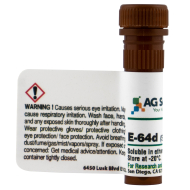E-64 is an irreversible, potent and highly selective inhibitor of cysteine proteases. It does not affect cysteine residues in other enzymes. E-64 acts by forming a thioether bond with thiol of the active cysteine. E-64 will not inhibit serine proteases (except trypsin). It inhibits activation-induced programmed cell death and restores defective immune responses in HIV+ donors.

E-64 is a very useful cysteine protease inhibitor for use in in vivo studies because it has a specific inhibition, it is permeable in cells and tissues, and has low toxicity. E-64 inhibits calpain, papain, and cathespin B, cathepsin L, bromelain, staphopain, collegenase and ficin. The compound has been reported to inhibit intracellular Bax protease activity, and reduce oxidative stress, which includes a decrease in MDA levels, ICAM-1 expression and MOP activity. E-64 has also been used to study excystation, (microbial cyst wall breaks down) in Giardia lamblia.

Appearance
White crystalline powder
Chemical Name
trans-Epoxysucciny-L-leucyl-amido(4-guanidino) butane; (L-3-trans-Carboxyoxiran-2-Carbonyl)-L-Leucyl-Admat, L-trans-3-Carboxyoxiran-2-carbonyl-L-leucylagmatine, N-(trans-Epoxysuccinyl)-L-leucine 4-guanidinobutylamide
Examples of Cysteine Proteases
Actinidain, Bromelain, Calpains, Caspases, Cathepsins, Mir1-CP, Papain.
Source
The compound E-64 was first isolated and identified from the fungus, Aspergillus japonicus in 1978.
Chemical Formula
C15H27N5O5Molecular Weight
357.4CAS#
66701-25-5Solubility
DMSO (25 mg/mL) and H20 (20 mg/mL)A 20 mg/mL solution can be prepared in water (heat may be needed). A suggested water stock solution is a 1 mM aqueous solution.
E-64 is also soluble in DMSO; a 10 mM solution can be prepared in dry DMSO and stored at -20 °C.
If aqueous stock solutions are required for biological experiments, they can best be prepared by diluting the organic solvent into aqueous buffers or isotonic saline. Ensure that the residual amount of organic solvent is insignificant, since organic solvents may have physiological effects at low concentrations.
We do not recommend storing the aqueous solution more than one day. Solutions for injection have been prepared by dissolving E-64 in 0.9% sodium chloride or in a minimum amount of saturated sodium bicarbonate followed by dilution with 0.9% sodium chloride (after adjusting the pH to 7.0 with acetic acid.
pH Range
Diluted solutions are stable for days at neutral pH. E-64 is stable from pH 2-10Purity
99% BY HPLC.Incompatabilities
E-64 is unstable in ammonia or in HCl.Effective Concentration
The effective concentration for use as a protease inhibitor is 1 to 10 µM.Storage
Store, as supplied, at -20°C for up to 1 year. Store solutions at -20°C for <3 months.RTECS#
RR0390000What is an RTECS (Registry of Toxic effects of Chemical Substances) Number and what does it tell us?
RTECS is a compendium of data extracted from the open scientific literature. The data are recorded in the format developed by the RTECS staff and arranged in alphabetical order by prime chemical name.Six types of toxicity data are included in the file:
(1) primary irritation
(2) mutagenic effects
(3) reproductive effects
(4) tumorigenic effects
(5) acute toxicity
(6) other multiple dose toxicity.
Specific numeric toxicity values such as LD50, LC50, TDLo, and TCLo are noted as well as species studied and route of administration used. For each citation, the bibliographic source is listed thereby enabling the user to access the actual studies cited. No attempt has been made to evaluate the studies cited in RTECS. The user has the responsibility of making such assessments

